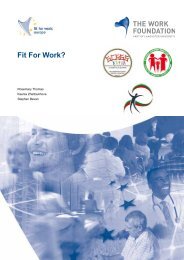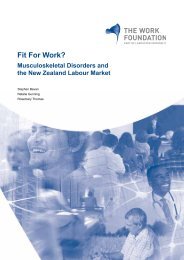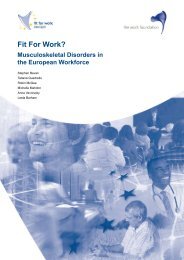English version - Fit for Work Europe
English version - Fit for Work Europe
English version - Fit for Work Europe
You also want an ePaper? Increase the reach of your titles
YUMPU automatically turns print PDFs into web optimized ePapers that Google loves.
Introduction<br />
3. How well do employers, governmental bodies, clinicians and occupational health<br />
professionals understand and deal with MSDs as they relate to the workplace? How<br />
well equipped is the health sector to provide early intervention, rehabilitation and other<br />
support <strong>for</strong> people with these conditions?<br />
4. What early interventions can policy-makers and employers deliver to ensure that<br />
those with MSDs a) retain their jobs b) maximise their quality of working life and their<br />
contribution to society and c) maintain access to (and routes back into) employment?<br />
In addressing the objectives outlined above, we have used the following approaches:<br />
1. Desk research: Here we have drawn on existing published research from the medical,<br />
occupational health and health economics literature. This has enabled us to bring<br />
together the evidence on the nature, extent, impact and costs of MSDs to the Japanese<br />
economy, to employers and to individuals. We have examined a range of MSDs to<br />
assess the extent to which their impact varies and where policy and practice has been<br />
both strong and weak in preventing and intervening.<br />
2. Secondary data analysis: We have used data from domestic and regional studies and<br />
surveys to examine the prevalence and costs of MSDs in the working age population in<br />
Japan.<br />
3. Expert interviews: We have conducted interviews with sixteen Japanese experts across<br />
a number of disciplines (including occupational health, policy making, consulting,<br />
rheumatic disease, neck and back pain) to identify the main areas of policy and practice<br />
which need to be addressed by policy makers, health professionals and by employers.<br />
In addition to the wider picture, to focus the research, we have chosen to concentrate on four<br />
categories or groups of MSDs. These are:<br />
• Back pain;<br />
• <strong>Work</strong>-related upper-limb disorders such as regional pain and non-specific <strong>for</strong>earm pain<br />
(WRULDs);<br />
• Rheumatoid arthritis (RA);<br />
• Spondyloarthropathy (SpA).<br />
Back pain and the majority of WRULDs are categorised as non-specific and episodic conditions<br />
which may frequently be caused by, or be made worse by, work. They manifest themselves in<br />
disparate ways and may cause periods of intense discom<strong>for</strong>t and incapacity which may affect<br />
the ability of the individual worker to carry out their work. They may also abate <strong>for</strong> long periods.<br />
Many people with these conditions, such as back pain, never seek treatment and most recover<br />
<strong>Fit</strong> For <strong>Work</strong>? Musculoskeletal Disorders and the Japanese Labour Market 13







